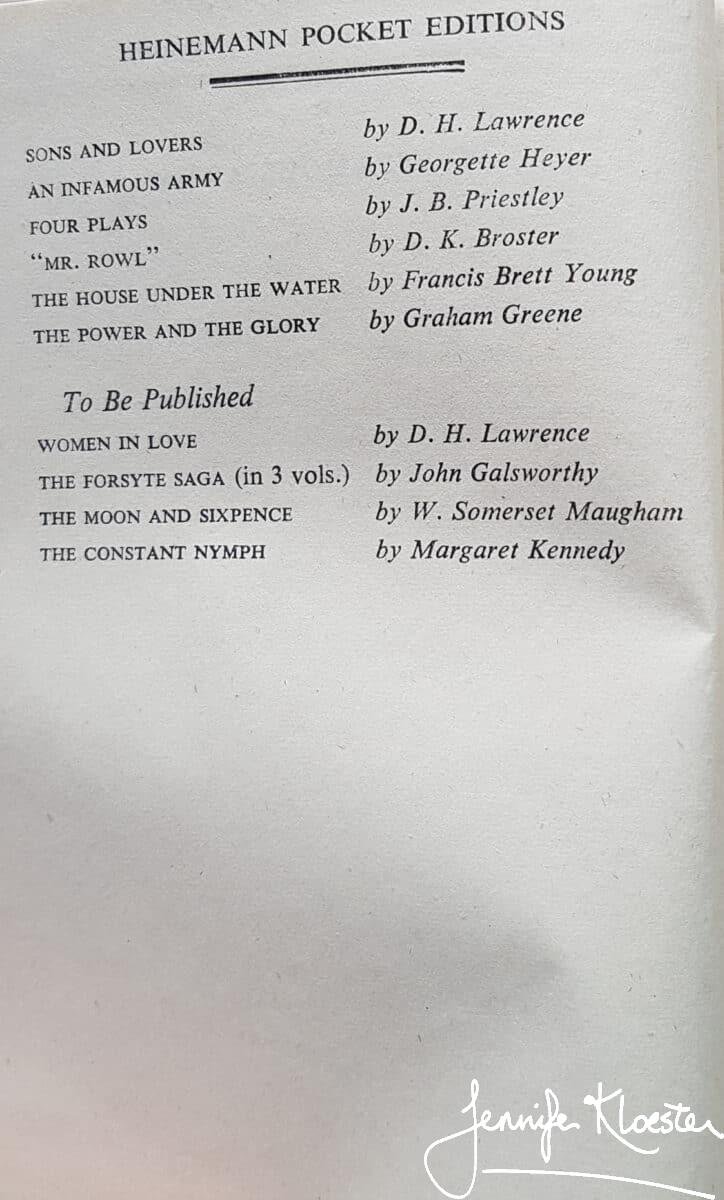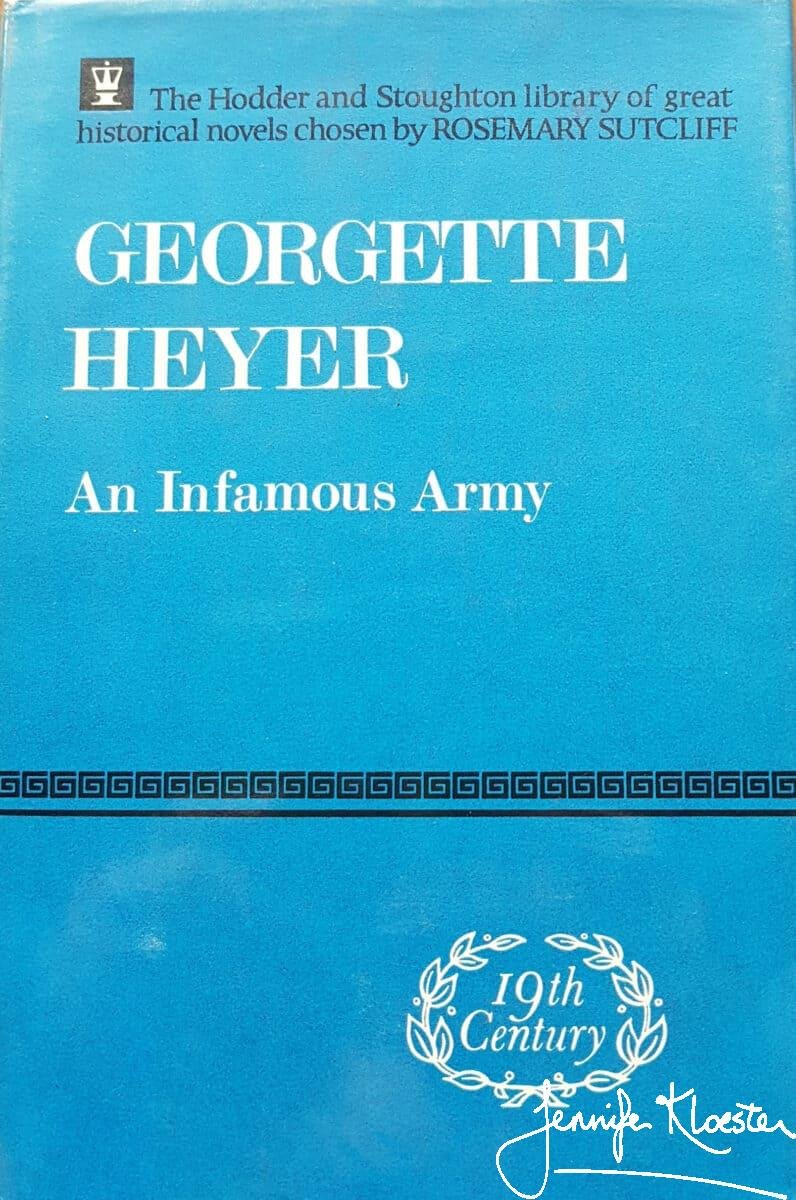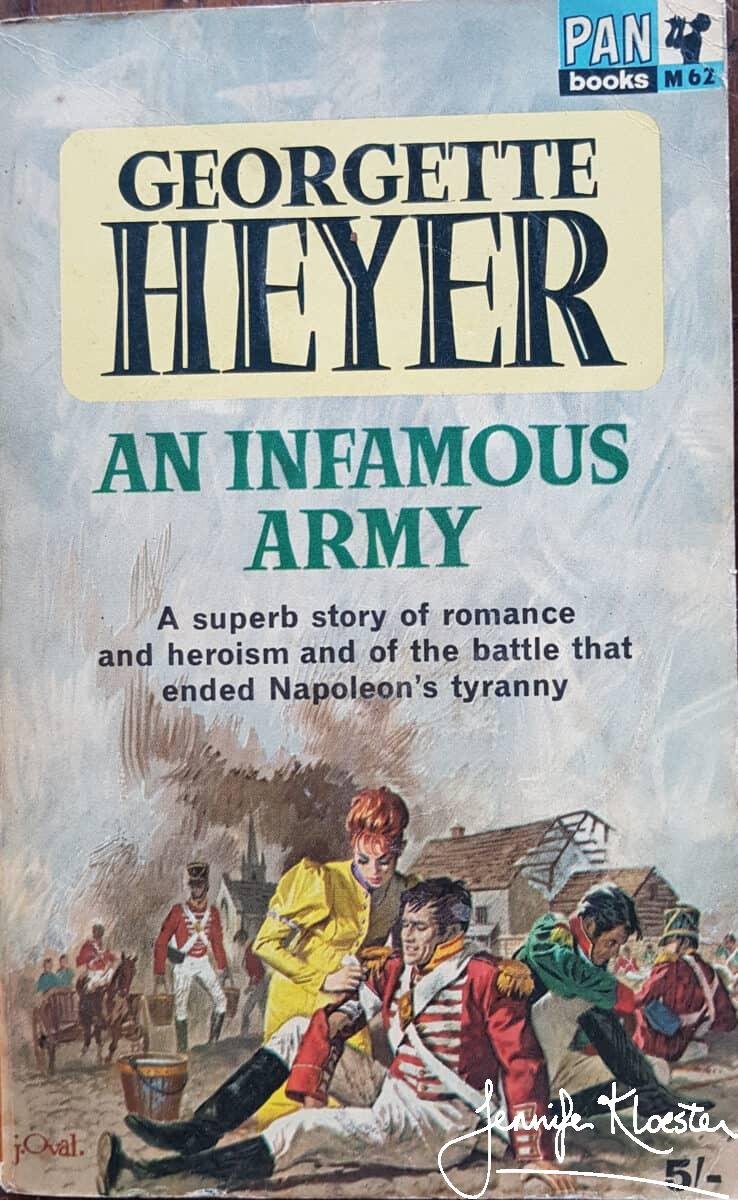
Her most ambitious
In mid-November 1936, Georgette Heyer was writing the final chapters of her murder mystery, They Found Him Dead . She finished it by the end of the month and two months later, in January 1937, she began researching a new historical novel. For over four months, Heyer read every book about the Napoleonic Wars and the Battle of Waterloo that she could lay her hands on (nowhere near as many as there are available nowadays). She was excited by the new book which would be her most ambitious and, for many readers, her greatest achievement. She would eventually call the novel An Infamous Army and on completing it sent a plot summary to a new contact at Heinemann: Alexander Frere-Reeves.
There are 26 chapters, of which the final 10 deal with the actual campaign. This is, I think, the right proportion, & comes to a little over a third of the entire book. The story opens on the 4th April 1815, in Brussels. Wellington arrived from Vienna very late that night, & my hero comes with him. This, as you know, is Colonel Audley – who appeared in Regency Buck. His sister-in-law – Judith (heroine of Regency Buck) has found a demure bride for him. Unfortunately, he falls instantly in love with Barbara Childe, Devil’s Cub’s granddaughter – a red-haired, dashing & unprincipled widow of 25. She is very fast, & rather fun. She & the Colonel become engaged, but it is soon seen that there are rocks ahead. This early part is freely interspersed with Wellington’s doings. Don’t let Heinemann be afraid! The Wellington chapters are my best, & most amusing!
Georgette Heyer to Norah Perriam, letter, 23 August 1937

Utterly absorbed
As the projected book took shape in her mind, she became absorbed by the psychology of her characters and the ways in which their various roles in the battle might heighten the drama of her fictional plot. Her hero, Charles Audley, had played a minor role in Regency Buck but she now cast him as a Colonel in the 10th Hussars and subsequently attached to the Duke of Wellington’s staff. When the book opens, Charles’s brother, the Earl of Worth, Judith Taverner (now Lady Worth), her brother Peregrine and his wife, Harriet, are all staying at Worth’s house in Brussels and Georgette took great delight in having several real historical figures, including the diarist, Thomas Creevey, Georgiana Lennox and young Lord Hay, pay them a morning visit. Georgette brilliantly recreates Brussels on the eve of battle with everyone eager for news of Wellington and wondering what will happen in the coming days. Her idea was to ‘lay the situation before the reader, & convey the feeling of alarm & uneasiness before Wellington’s arrival from Vienna’ and Heyer achieves this with all her usual verve and flair.

“Only the triangle of one girl and 2 men”
Heyer told her agent that ‘There’s not a speck of adventure (in the style of the Talisman Ring)’ but that she was sure she could carry the story off with ‘only the triangle of one girl and 2 men, & the crashing climax of Waterloo’. As she would tell Frere-Reeves a few months later, the heroine, Lady Barbara Childe, was the granddaughter of Devil’s Cub, also known as Dominic Alastair, son of the Duke of Avon in These Old Shades ,and the Marquis of Vidal in her 1931 novel, Devil’s Cub. Vidal is now Duke of Avon and ‘Bab’ is a true Alastair having inherited her great-grandmother Léonie’s flaming red hair, extraordinary beauty and her temper. Many readers have noted the impossible chronology of the Alastair family tree as Georgette depicted it and she later acknowledged ‘that Dominic couldn’t have had grand-children of mature age in 1815′. Georgette had included the Alastair descendants because she felt that the characters’ popularity was such that her readers would forgive a little poetic licence. She never intended An Infamous Army to be a true sequel to Devil’s Cub and her son, Sir Richard Rougier, later explained that his mother simply gave Mary and Dominic Alastair parts in the novel ‘as a sort of friendly wave to previous readers’.
Charles Audley
The two men in the ‘triangle’ were Charles Audley and a Belgian, the Comte de Lavisse, a fictional member of Bylandt’s brigade which retreated from the Battle of Waterloo early in on the action. Georgette described his role as: ‘A nice, though flamboyant young man, but you see the psychological point, don’t you? No romantic girl would look at a defeated man when the other behaved with successful gallantry, & been borne off the field desperately wounded.’ The ‘other man’ was to be Colonel Charles Audley, who, as Georgette explained:
went to the Dss of Richmond’s ball in all the splendour of his Hussar uniform – that is how the girl saw him last on the 15th June. Like so many others, he had no time to change before riding to Quatre Bras on the 16th. He went in full ball-dress, & was sent back on the 17th June, with despatches for the English Ambassador at Brussels, & found time to go to his quarters (the house his brother Worth rented) to change into staff clothes. So then the girl saw him again, with all his splendid ball dress soaked with rain, plastered with mud – oh, you do get it, don’t you? And I think he isn’t interested in her, tho’ she is all melting. He wouldn’t be. He is dog-tired, knows there’s going to be the hell of a battle next day, & seems scarcely aware of her. Just tells Worth disjointed details of the action at Quatre Bras, & the rear-guard fighting at Genappes.
Georgette Heyer to Norah Perriam, letter, 4 MArch 1937.
It is not often that we gain a direct insight into what was going on in Georgette Heyer’s mind while she was writing her novels but here is a moment which reveals not only the scene but also the psychology behind it. Heyer is a romantic and her heartfelt plea to her agent’s assistant “oh, you do get it, don’t you?” conveys so much of her feelings both for and about her characters. She is so good at depicting human emotion and getting the best out of an encounter between her hero and heroine and it’s obvious that she is really seeing the scene with all of its intense drama and pathos as she writes it.

The 1944 Heinemann Pocket Edition 
Georgette Heyer in good company in the 1944 Pocket Editions
Reported anecdotally
For many years it has been reported anecdotally that An Infamous Army has long been recommended to students at Sandhurst for its account of the Battle of Waterloo. Heyer’s son confirmed this but, eager to discover more concrete evidence, I wrote to Sir John Keegan the eminent military historian, teacher at Sandhurst from 1960-1986, and the Defence Editor of he Daily Telegraph. to ask him if the story were true. Sir John has written many books about the history of warfare (including about Waterloo in his The Face of Battle and he confirmed the story. I also contacted Major-General Jeremy Rougier who had attended Sandhurst as an officer cadet, before becoming an Instructor and company commander. Major-General Rougier went on to become Director of Army Training and the Engineer-in-Chief of the British Army. It is worth noting he is Ronald’s nephew though this in no way affected his experiences at Sandhurst where An Infamous Army was indeed recommended reading for its vivid account (from the British point of view) of the Battle of Waterloo. In 2002 Major-General Rougier’s corroborative letter to me also included a delightful story:
I can illustrate the international respect that her book attracted. In 1964 I was a military assistant to a member of the Army Board (the top management of the Army) and he was paying an official visit to Belgium. We had a free afternoon; what should we do? “Why not ask the Professor of Military Studies at the Belgium Military Academy to give us a conducted tour of Waterloo?” I said, and so he did. It was fascinating; he knew the position of every regiment at any time on both sides. “At about 3pm Napoleon was standing here – no, here” he would say, moving 10 foot to record the precise spot. At the end I presented him with a copy of Georgette’s book and explained our connection. He was as near speechlessness as a professor of military history can be. “This” he said, holding up the book, “is the nearest to reality that one will ever come without having been there.”
Major-General Rougier to Jennifer Kloester, letter, 11.11.2002

“Perfect reading”
In 1966 Hodder & Stoughton gained permission to republish An Infamous Army as part of their “Library of Great Historical Novels” series. The beloved historical novelist, Rosemary Sutcliff chose the first four titles and An Infamous Army was her first pick. She wrote a long Introduction to the novel which began with high praise for Georgette Heyer:
‘For me, the Regency Novels of Miss Georgette Heyer have always been perfect reading; and I think that this–apart from their more obvious delights–is because of their good manners…The writing itself–the actual choice and arrangement of words–is meticulous; Miss Heyer is incapable of a clumsy or slipshod phrase, and the likeness to Jane Austen which has developed in her work through the years is certainly not mere pastiche, but comes of a like habit of mind, and a like attitude to written English–a beautifully polished but never glossy English.
Rosemary Sutcliff, Introduction, An Infamous Army, Hodder & Stoughton, 1966.
High praise indeed, but not in the last undeserved, for An Infamous Army is a book to be proud of and one which has brought many readers (including my PhD supervisor) to appreciate Georgette Heyer’s remarkable talent. Her tale of Waterloo, entwined as it is with a rocky romance and tested relationships, real people in her fiction and fictional people who seem real, is stirring and memorable. It also laid a firm foundation for the Regency novels to come. Nor was she quite done with the Napoleonic Wars. Her reading had unexpectedly convinced her of Wellington’s acumen and achievements and two years later she would return to him in The Spanish Bride. As she later said of the Iron Duke: ‘I came to curse & stayed to praise.’ An Infamous Army is a remarkable achievement and in years to come it would be the novel of which Georgette Heyer would be most proud.

1961 Pan Giant edition 
1965 Pan edition







3 thoughts on “An Infamous Army – a triumph”
Just recently have been rereading my Georgette Heyer books. Regency Buck (circa 1812) with Judith Tavener and the Earl of Worth.
Discovered Charles Audley was depicted as having lost his arm already, . However Infamous Army (1815) has him losing it on battlefield. Wondered when Regency Buck was written and did Miss Heyer address this oddity.???
IIRC wasn’t he wounded in that arm in Regency Buck? he says in An Infamous Army that it’s a very unlucky limb, having been wounded before.
Yes, can confirm that quote from Regency Buck, as I read it only yesterday! Infamous Army is one of my all-time favorites by ANY writer. Another favourite is “The Spanish Bride”
PS. Did you know that Harry Smith and Juana were real people? He came from Wisbech, in Eastern England; I did my 2nd-year Teaching Practice there, and there is at least one school and other places named after him! They are very proud of him!